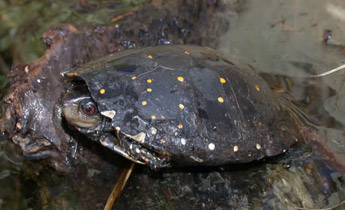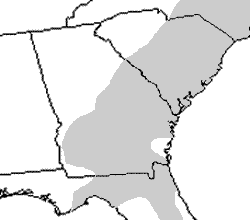Spotted Turtle (Clemmys guttata)



Photos by J.D. Willson unless otherwise noted
Description: Spotted Turtles are small — 3 ½ – 4 ½ inches (9-11.5 cm) – aquatic turtles that are black in color with yellow spots. Hatchlings usually have one spot per large scute on the shell but adult spotting patterns are variable. The shell is flattened and there is orange or yellow coloration on the head, neck, and forelegs. Males have longer tales than females.
Range and Habitat: This species can be found throughout the east coast of the United States and the Great Lakes region. In our area, Spotted Turtles are found throughout the Coastal Plain, including several barrier islands, but are found in spotty populations and are generally fairly uncommon. Favored habitats are shallow aquatic habitats, often with abundant vegetation, including ditches, Carolina Bays, bogs, and cypress swamps.
Habits: Relatively little is known about Spotted Turtle biology in the Southeast and they appear to have quite different activity patterns from other aquatic turtles. These turtles appear to be most common in the early spring when they can be seen basking on logs in wetlands. Data from radio-telemetry suggests that Spotted Turtles spend much of the warmer months buried on land. Sexual maturity is reached at 8-10 years and the turtles may live as long as 25 years. Diet consists of snails, worms, slugs, and insects.
Conservation Status: The spotted turtles are uncommon but are not protected in our region. However, their specific habitat requirements and slow reproductive rate make this species a conservation concern. In some regions collecting for the pet trade has been implicated in population declines. .
Pertinent References:
Litzgus, Jacqueline D. and Mousseau, Timothy A. 2002. Multiple clutching in Southeastern Spotted Turtles, Clemmys guttata. Journal of Herpetology: Vol. 37; 17-23.
Litzgus, J. D. and T. A. Mousseau. 2004. Demography of a southern population of the spotted turtle (Clemmys guttata). Southeastern Naturalist 3:391-400.
Account Author: Jason Norman, University of Georgia – edited by J.D. Willson
